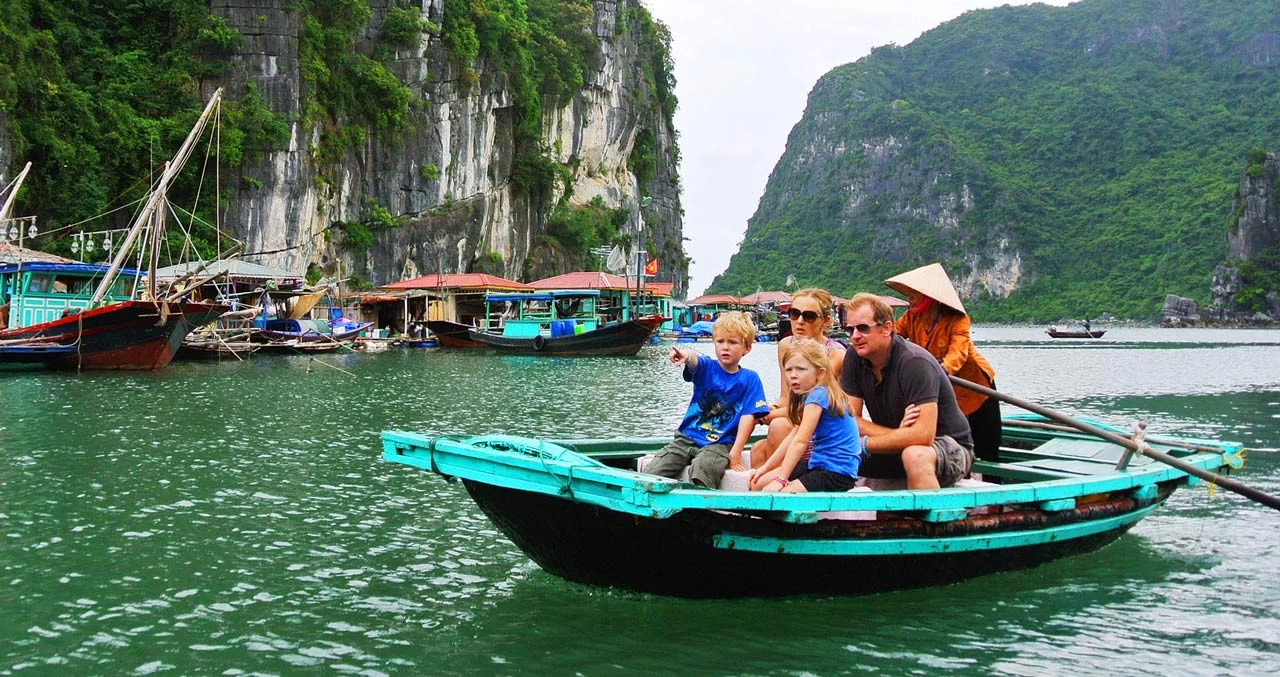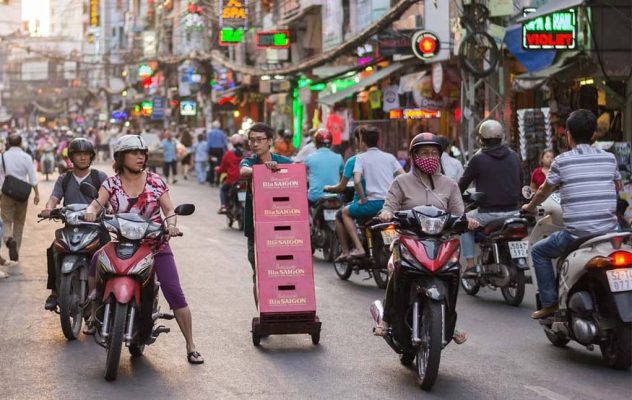
Let’s overcome the fear of traffic in Vietnam with Ula Travel!
Traffic in Vietnam is a fascinating yet chaotic experience that reflects the country’s vibrant energy and rapid urban development. From the bustling streets of Hanoi and Ho Chi Minh City to the quieter roads in the countryside, the traffic culture varies widely across regions. Follow Ula Travel to learn about traffic culture in Vietnam!
I. Brief Overview of Traffic in Vietnam
Vietnam is known for its vibrant culture, rich history, and stunning landscapes, but its traffic is equally iconic and often leaves a lasting impression on visitors.
From the chaotic streets of Hanoi and Ho Chi Minh City to the more laid-back roads of smaller towns, traffic in Vietnam is a unique experience shaped by the country’s rapid urbanization and the high prevalence of motorbikes. The streets often seem like a flowing river of two-wheelers, mixed with cars, bicycles, buses, and pedestrians navigating narrow lanes and roundabouts with minimal traffic signals.
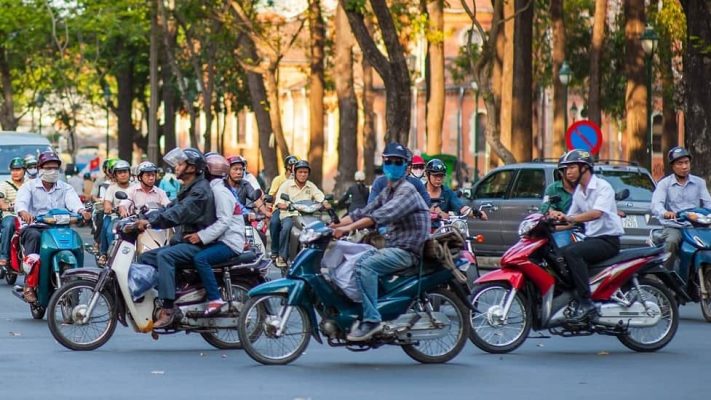
Traffic culture in Vietnam is the first shock to most tourists.
Traffic in Vietnam is characterized by its density, diversity, and unique driving culture. Motorbikes dominate the roads, making up approximately 75-80% of vehicles, as they are an affordable and convenient means of transportation for the majority of the population. Major cities like Hanoi and Ho Chi Minh City experience heavy congestion, especially during peak hours.
The driving style in Vietnam is often described as intuitive and fluid, with drivers relying heavily on honking as a form of communication rather than aggression. Traffic laws exist, but enforcement can be inconsistent, leading to a more flexible approach to road rules.
II. Traffic in Hanoi and Ho Chi Minh City
Hanoi and Ho Chi Minh City, the two largest cities in Vietnam, experience some of the heaviest traffic congestion in the country. Hanoi, the capital, has narrow, winding streets, particularly in areas like the Old Quarter, making it prone to bottlenecks during rush hours. Ho Chi Minh City, with its larger road network, also faces significant traffic, especially in districts like District 1 and District 3, where commercial activities are concentrated.
1. Common Modes of Transport
Vietnam traffic is defined by its diversity of vehicles. Among the most popular forms of transportation are:
- Motorbikes: Motorbikes dominate Vietnam’s roads, making up the majority of vehicles. They are preferred due to their affordability, fuel efficiency, and ease of maneuvering through narrow streets.
- Cars: While cars are becoming more common, especially among the middle and upper classes, they are still less frequent than motorbikes. Traffic congestion is often worsened by the increasing number of private cars in urban centers.
- Bicycles: Bicycles, once a staple of Vietnamese transport, are now less common in major cities but still used in rural areas and by school children in towns.
- Buses: Public buses operate in most major cities, providing an affordable transport option. However, they are often overcrowded during peak hours and can contribute to traffic delays due to frequent stops.
- Taxis and Ride-Hailing Services: Taxis and services like Grab and Gojek have become popular for convenience, though they can also add to road congestion.
2. Peak Hours and Typical Traffic Patterns
Traffic congestion in Vietnam generally follows a predictable pattern:
- Morning Rush Hour: From around 7:00 AM to 9:00 AM, as people commute to work and school.
- Evening Rush Hour: From 5:00 PM to 7:00 PM, as workers return home and businesses close for the day.
- Lunchtime Lull: Traffic tends to ease slightly around noon, though commercial areas can remain busy.
- Night Traffic: After 9:00 PM, traffic usually subsides except in nightlife districts and areas with evening markets.
III. Vietnam Traffic Culture
Vietnam traffic culture is a fascinating blend of tradition, necessity, and adaptation to rapid urbanization. With its dynamic energy and unique patterns, understanding the traffic culture in Vietnam provides deeper insight into the daily life and habits of its people.
1. Motorbike Culture in Vietnam
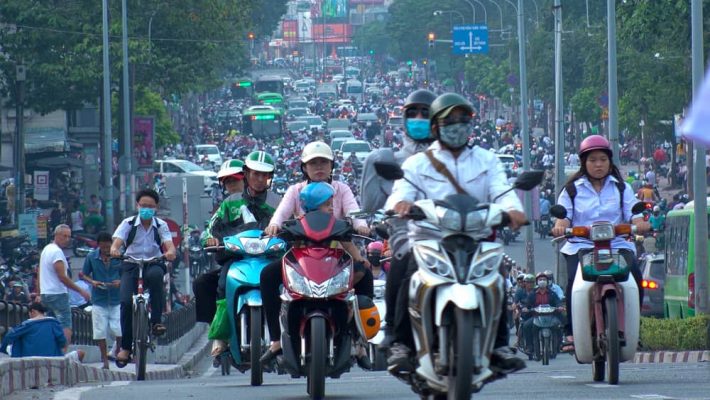
Vietnam is the world’s number 2 country in terms of motorbike usage rate.
Motorbikes are the lifeblood of Vietnam’s traffic system. Accounting for nearly 80% of vehicles on the road, they are the preferred mode of transportation for several reasons:
- Affordability and Accessibility: Motorbikes are cheaper than cars and offer a more affordable option for the majority of the population. Their lower fuel consumption and maintenance costs make them ideal for everyday use.
- Narrow Streets and Urban Design: Vietnam’s older cities, like Hanoi and Ho Chi Minh City, have narrow streets, making motorbikes the most practical choice for navigating tight spaces.
- Efficiency in Congestion: Motorbikes can weave through traffic more easily than cars, helping riders avoid long delays during rush hours.
- Cultural Familiarity: The use of motorbikes dates back decades, becoming deeply embedded in Vietnamese culture. Families often pass down motorbikes across generations.
2. Crossing the Street in Vietnam
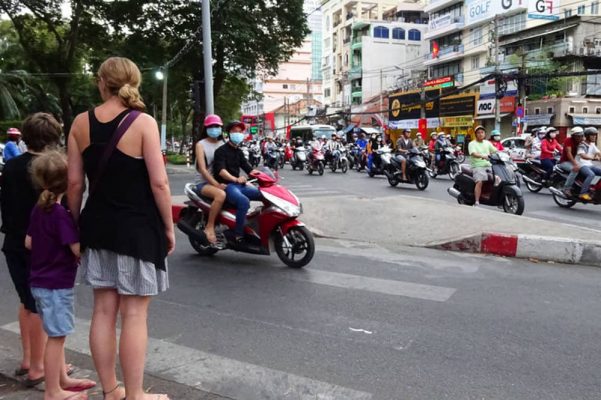
Crossing the street in Vietnam is a challenge for tourists.
Crossing the street in Vietnam can be a daunting experience for first-time visitors due to the chaotic flow of vehicles and lack of formal pedestrian regulations. However, there is a unique rhythm to how traffic moves:
- Flow over Rules: Traffic often relies more on flow than strict adherence to signals. Drivers adjust their speed and paths based on other vehicles rather than traffic lights alone.
- Lack of Pedestrian Priority: Zebra crossings and pedestrian lights are often ignored, placing the responsibility on the pedestrian to navigate the traffic carefully.
Start your journey with: Vietnam Tour Package 14 Days
3. Honking Culture in Vietnam Traffic
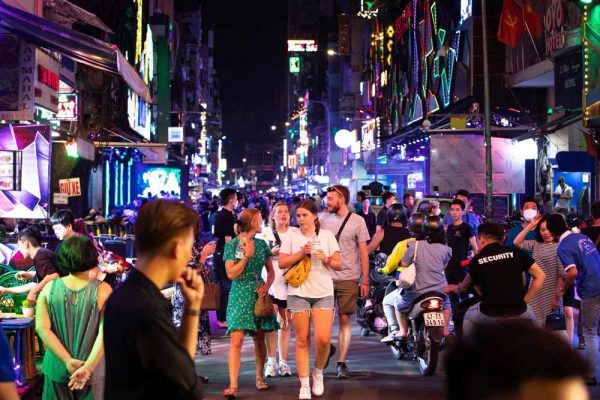
Vietnamese people often honk for many different purposes.
Honking in Vietnam serves multiple purposes beyond frustration or aggression, making it an essential part of the traffic culture:
- Communication Tool: Drivers use honking to signal their presence, especially when overtaking or approaching intersections.
- Alerting Pedestrians: Honks are often used to warn pedestrians who may be crossing unexpectedly or walking too close to the road.
- Navigational Cue: In dense traffic, honking helps alert nearby vehicles of a driver’s intention to merge or maneuver.
- Cultural Habit: The frequent honking can feel overwhelming to outsiders, but it is generally seen as a practical necessity rather than rudeness.
Vietnam traffic culture reflects a unique blend of historical influences, urban challenges, and practical solutions adapted to local realities. While it may seem chaotic to outsiders, it operates with an underlying order shaped by the habits and understanding of its people.
IV. Traffic Safety Tips for Tourists
Vietnam is famous for its vibrant culture, delicious cuisine, and breathtaking landscapes. However, the country’s traffic can be overwhelming for first-time visitors. Understanding local traffic habits and safety precautions is crucial for a smooth and secure travel experience. Here are essential safety tips for tourists navigating Vietnam’s roads.
1. How to Cross the Street in Vietnam
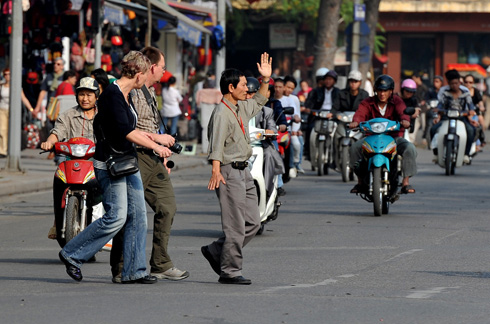
When crossing the street, look and signal to oncoming vehicles.
Crossing the street in Vietnam, especially in major cities like Hanoi and Ho Chi Minh City, can be challenging due to the constant flow of motorbikes and cars. For a safer experience, abide by following guidelines:
- Walk Steadily and Confidently: Move at a slow, consistent pace without sudden stops or rushing.
- Make Eye Contact: Try to establish eye contact with approaching drivers to ensure they see you.
- Raise Your Hand: Some locals raise a hand to signal their intent to cross, which can help drivers notice you.
- Avoid Hesitation: Hesitating or stepping back can confuse drivers who are anticipating your path.
- Cross at Intersections When Possible: Although pedestrian crossings may not always be respected, intersections offer a slightly safer option.
- Follow Locals: If unsure, cross alongside a local who understands the flow better.
2. Pedestrian safety rules in Vietnam
Pedestrian safety requires attentiveness and an understanding of local habits. Keep these tips in mind:
- Stay on Sidewalks: Use sidewalks where available, though they may be crowded or used for parking.
- Avoid Using Phones: Stay focused and avoid distractions while walking.
- Watch for motorbikes on sidewalks: Some motorbikes use sidewalks during heavy traffic.
- Be Cautious at Night: Visibility can be lower in some areas, so avoid dimly lit streets and wear bright clothing if possible.
Do not miss: Best Vietnam Discovery Tour
3. Wearing Helmets When Riding Motorbikes
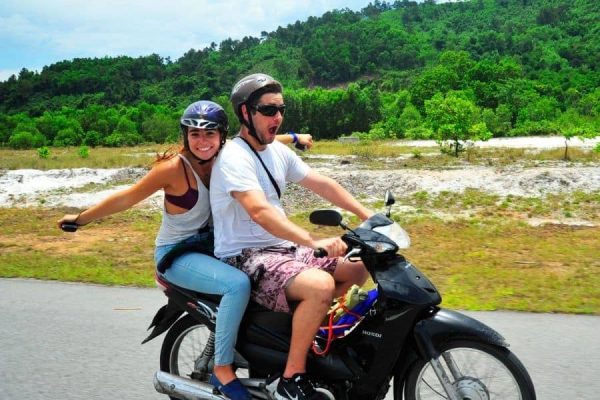
Remember to always wear a helmet when riding a motorbike.
In Vietnam, motorcycles are the most used form of transportation. If you plan to ride a motorbike or join a motorbike tour, wearing a helmet is essential.
- Choose Certified Helmets: Always use helmets meeting safety standards with proper cushioning and a secure strap.
- Fit Matters: Ensure the helmet fits snugly and covers the forehead properly.
- Wear It Correctly: Secure the chin strap and avoid loose helmets that could slip off during impact.
- Rent from Reputable Services: If renting a motorbike, ensure the rental service provides quality helmets.
V. Basic Traffic Laws in Vietnam
Vietnam has a complex traffic system with laws that may differ significantly from those in Western countries. If you plan to drive or rent a vehicle while visiting, it is essential to understand the key regulations:
- License Requirements: In addition to their driver’s license from their home country, tourists must have an International Driving Permit (IDP). However, IDPs must be officially recognized in Vietnam, so verifying validity before travel is crucial.
- Helmet Use: Helmets are mandatory for both drivers and passengers on motorbikes. Ensure the helmet meets safety standards.
- Speed Limits: Urban areas have a speed limit of 50 km/h (31 mph), while highways range from 80 to 120 km/h (50 to 75 mph).
- Alcohol Limits: The blood alcohol content (BAC) limit is zero for motorbike riders and 0.05% for car drivers, with strict enforcement and hefty fines for violations.
- Right of Way: Vehicles generally yield to larger vehicles. Pedestrians must be cautious as crosswalk rules are often ignored.
- Motorbike Restrictions: Some areas, such as Hanoi’s Old Quarter, restrict motorbike use during peak hours.
VI. Transportation Options for in Vietnam
Vietnam traffic can be overwhelming for first-time visitors due to its busy streets, a high volume of motorbikes, and unique driving patterns. However, with the right transportation choices, exploring the country can be convenient and memorable. Here is a detailed guide on transportation options available for tourists in Vietnam.
1. Public Buses and Their Usability for Tourists
Public buses are the most budget-friendly transportation option in Vietnam. Major cities like Hanoi, Ho Chi Minh City, and Da Nang have extensive bus networks covering most tourist areas. Fares typically range from 7,000 to 10,000 VND (less than $0.50 USD), making them highly affordable.
Pros:
- Extremely affordable
- Suitable for budget travelers
- Covers most parts of major cities
Cons:
- Language barrier, as drivers and conductors often speak limited English
- Complicated routes for non-locals
- Overcrowding during peak hours
Tips:
- Use the apps BusMap or Moovit for route navigation.
- Keep small change for tickets, as large bills may not be accepted.
2. Taxis and Ride-Hailing Apps (Grab, Be)
Taxis and ride-hailing apps offer a more convenient and comfortable way to travel in Vietnam. Conventional cab services like Vinasun and Mai Linh are well-known for their dependability and accessibility.
Ride-Hailing Apps:
- Grab: The most popular ride-hailing app, offering both cars and motorbikes.
- Be: A local competitor to Grab, often slightly cheaper.
Pros:
- Convenient and widely available in urban areas
- Fixed fares with ride-hailing apps, preventing scams
- Suitable for tourists who prefer cashless payments
Cons:
- Slightly more expensive than public buses
- Traffic congestion may affect travel times.
Tips:
- Always check for the official taxi logos (Mai Linh, Vinasun) to avoid unlicensed taxis.
- Use apps with location tracking for safety.
3. Motorbike Rentals
Renting a motorbike is a popular choice for adventurous tourists wanting to explore Vietnam independently. Daily rental rates range from $5 to $10 USD, and bikes are available in most tourist hotspots.
Pros:
- Flexibility and freedom to explore remote areas
- Affordable rental prices
- Perfect for scenic routes like the Ha Giang Loop and Hai Van Pass
Cons:
- Vietnam’s traffic can be chaotic and challenging for inexperienced riders.
- High accident rates
- License requirements: An international driving permit (IDP) is legally required.
Tips:
- Always wear a helmet and ensure the motorbike has proper insurance.
- Choose reputable rental services with well-maintained bikes.
4. Private Cars and Driver Services
Private car services with a driver offer the most comfortable and stress-free way to explore Vietnam, especially for families or groups. Services are available for airport transfers, day trips, and multi-day tours.
Pros:
- Highly comfortable and safe
- Suitable for long-distance travel
- Drivers familiar with tourist routes and destinations
Cons:
- More expensive than other options
- Less flexible than motorbike rentals
Tips:
- Book through reputable companies or hotels for quality service.
- Clarify costs upfront, including toll fees and waiting charges.
VII. Traffic Outside Major Cities
Vietnam’s traffic outside major cities presents a unique contrast to the bustling chaos often seen in urban hubs like Hanoi or Ho Chi Minh City. The rural areas, scenic routes, and popular tourist destinations each offer distinct driving experiences that international visitors should be prepared for.
1. Traffic in Rural Areas vs. Urban Centers
Traffic in Vietnam varies significantly between rural areas and urban centers. Urban centers are characterized by heavy congestion, especially during rush hours, with a constant flow of motorbikes, cars, buses, and pedestrians sharing the roads. Traffic lights and lanes can feel optional, as locals often navigate through the chaos with remarkable skill.
In contrast, rural areas experience lighter traffic, making them more peaceful and easier to navigate. However, road conditions can be challenging, with narrow paths, dirt roads, and limited signage. Agricultural vehicles, bicycles, and livestock frequently share the roads, requiring drivers to stay alert. The pace is slower, and the absence of traffic lights means interactions rely on mutual understanding and caution.
Click here: Unforgettable Cross-Vietnam Tour in 11 Days
2. Scenic Routes in Vietnam
Vietnam offers stunning scenic routes, particularly in the northern and central regions. The Hai Van Pass, with its breathtaking coastal views, and the Ha Giang Loop, famous for its rugged mountain scenery, are prime examples.
However, the quality of road conditions varies. Major highways like the National Route 1A connecting Hanoi and Ho Chi Minh City are relatively well-maintained but can still experience traffic bottlenecks.
In more remote areas, roads can become narrow, unpaved, or affected by weather conditions such as landslides during the rainy season. Travelers are advised to rent reliable vehicles, consider guided tours for difficult routes, and avoid night driving due to limited lighting and visibility.
You will be like: Vietnam All-in-One Tour: A Lifetime Journey Awaits
3. Traffic at Popular Tourist Destinations
Tourist hotspots such as Halong Bay, Sapa, and Da Nang tend to have more organized traffic flow, particularly around resorts and hotels. However, during peak seasons or festivals, congestion can increase dramatically. Parking can be limited, and roads may become crowded with both local vendors and tour buses.
In smaller towns like Hoi An, motorized vehicles are often restricted in central areas, making it easier for pedestrians to explore. Conversely, destinations like the Mekong Delta might require navigating through busy ferry crossings and narrow village roads, where local traffic patterns can be unpredictable.
In conclusion, traffic in Vietnam is a fascinating blend of culture, modern development, and local habits. While it may seem overwhelming at first, it reflects the country’s vibrant pace of life and adaptability. Understanding the informal driving rules and staying alert can help visitors navigate more safely and appreciate the unique rhythm of Vietnam’s streets. Whether exploring by motorbike, taxi, or on foot, experiencing Vietnam’s traffic is an essential part of understanding its urban energy and local lifestyle.
See more: Vietnam Overview








